Assessing Multi-Micronutrients Deficiency in Agricultural Soils of India
Abstract
:1. Introduction
2. Materials and Methods
2.1. Study Area
2.2. Soil Sampling and Analysis
2.3. Statistical Analysis
3. Results
3.1. Concentration of Available S, Zn, B, Fe, Cu and Mn
3.2. Distribution of Single Nutrient Deficiencies of S, Zn, B, Fe, Cu and Mn
3.3. Distribution of Multi-Nutrient Deficiencies of S, Zn, B, Fe, Cu and Mn
4. Discussion
4.1. Concentration of Available S, Zn, B, Fe, Cu and Mn
4.2. Distribution of Single Nutrient Deficiencies of S, Zn, B, Fe, Cu and Mn
4.3. Distribution of Multi-Nutrient Deficiencies of S, Zn, B, Fe, Cu and Mn
5. Conclusions
Author Contributions
Funding
Institutional Review Board Statement
Informed Consent Statement
Data Availability Statement
Acknowledgments
Conflicts of Interest
Animal Research
Consent to Participate
Consent for Publication
References
- Singh, B.; Schulze, D.G. Soil Minerals and Plant Nutrition. Nat. Educ. Knowl. 2015, 6, 1. [Google Scholar]
- Cogger, C.; Brown, S. Soil formation and nutrient cycling. In Sowing Seeds in the City; Brown, S., McIvor, K., Hodges, S.E., Eds.; Springer: Dordrecht, The Netherlands, 2016. [Google Scholar] [CrossRef]
- Chapin, F.S. Patterns of nutrient absorption and use by plants from natural and man-modified environments. In Disturbance and Ecosystems. Ecological Studies (Analysis and Synthesis); Mooney, H.A., Godron, M., Eds.; Springer: Berlin/Heidelberg, Germany, 1983. [Google Scholar] [CrossRef]
- Marschner, P. Marschner’s Mineral Nutrition of Higher Plants; Academic Press: Adelaide, Australia, 2012. [Google Scholar] [CrossRef]
- Bhatt, P.; Verma, A.; Verma, S.; Anwar, M.S.; Prasher, P.; Mudila, H.; Chen, S. Understanding phytomicrobiome: A potential reservoir for better crop management. Sustainability 2020, 12, 5446. [Google Scholar] [CrossRef]
- Fendrihan, S.; Pop, C.E. Biotechnological potential of associated microorganism. Rom. Biotechnol. Lett. 2021, 26, 2700–2706. [Google Scholar] [CrossRef]
- Brevik, E.C.; Slaughter, L.; Singh, B.R.; Steffan, J.J.; Collier, D.; Barnhart, P.; Pereira, P. Soil and human health: Current status and future needs. Air Soil Water Res. 2020, 13, 1–23. [Google Scholar] [CrossRef]
- White, P.J.; Brown, P.H. Plant nutrition for sustainable development and global health. Annals Bot. 2010, 105, 1073–1080. [Google Scholar] [CrossRef] [PubMed] [Green Version]
- Shukla, A.K.; Behera, S.K.; Pakhre, A.; Chaudhari, S.K. Micronutrients in soils, plants, animals and humans. Indian J. Fert. 2018, 14, 30–54. [Google Scholar]
- Khurana, M.P.S.; Sadana, U.S. Bijay-Singh. Sulfur nutrition of crops in the Indo-Gangetic plains of south Asia. In Sulfur: A Missing Link between Soils, Crops, and Nutrition; Jez, J., Ed.; American Society of Agronomy: Madison, WI, USA, 2008; pp. 11–24. [Google Scholar] [CrossRef]
- Piotrowska-Dlugosz, A.; Siwik-Ziomek, A.; Dlugosz, J.; Gozdowski, D. Spatio-temporal variability of soil sulfur content and arylsulfatase activity at a conventionally managed arable field. Geoderma 2017, 295, 107–118. [Google Scholar] [CrossRef]
- Alloway, B.J. Micronutrient Deficiencies in Global Crop Production; Springer: Dordrecht, The Netherlands, 2008. [Google Scholar] [CrossRef]
- Shukla, A.K.; Behera, S.K.; Satyanarayana, T.; Majumdar, K. Importance of micronutrients in Indian agriculture. Better Crops South Asia 2019, 11, 6–10. [Google Scholar]
- Kihara, J.; Bolo, P.; Kinyua, M.; Rurinda, J.; Pikki, K. Micronutrient deficiencies in African soils and the human nutritional nexus: Opportunities with staple crops. Environ. Geochem. Health 2020, 42, 3015–3033. [Google Scholar] [CrossRef] [PubMed] [Green Version]
- Fageria, N.K.; Baligar, V.C.; Clark, R.B. Micronutrients in crop production. Adv. Agron. 2002, 77, 185–250. [Google Scholar] [CrossRef]
- Shukla, A.K.; Behera, S.K. All India research project on micro- and secondary nutrients and pollutant elements in soils and plants: Research achievements and future thrusts. Indian J. Fert. 2019, 15, 522–543. [Google Scholar]
- Manzeke, G.M.; Mtambanengwe, F.; Watts, M.J.; Hamilton, E.M.; Lark, R.M.; Broadley, M.R.; Mapfumo, P. Fertilizer management and soil type influence grain zinc and iron concentration under contrasting smallholder cropping systems in Zimbabwe. Sci. Rep. 2019, 9, 6445. [Google Scholar] [CrossRef]
- Shukla, A.K.; Behera, S.K. Biofortification for overcoming zinc and iron malnutrition in Indian population: Current research status and way forward. Indian J. Fert. 2020, 16, 1262–1276. [Google Scholar]
- Shah, F.; Wu, W. Soil and crop management strategies to ensure higher crop productivity within sustainable environments. Sustainability 2019, 11, 1485. [Google Scholar] [CrossRef] [Green Version]
- Shukla, A.K.; Behera, S.K.; Singh, V.K.; Prakash, C.; Sachan, A.K.; Dhaliwal, S.S.; Srivastava, P.C.; Pachauri, S.P.; Tripathi, A.; Pathak, J.; et al. Pre-monsoon spatial distribution of available micronutrients and sulphur in surface soils and their management zones in Indian Indo-Gangetic Plain. PLoS ONE 2020, 15, e0234053. [Google Scholar] [CrossRef]
- Steffan, J.J.; Brevik, E.C.; Burgess, L.C.; Cerda, A. The effect of soil on human health: An overview. Eur. J. Soil Sci. 2018, 69, 159–171. [Google Scholar] [CrossRef] [PubMed] [Green Version]
- Behera, S.K.; Shukla, A.K.; Prakash, C.; Tripathi, A.; Kumar, A.; Trivedi, V. Establishing management zones of soil sulphur and micronutrients for sustainable crop production. Land Degrad. Dev. 2021, 32, 3614–3625. [Google Scholar] [CrossRef]
- Soil Survey Staff. Keys to Soil Taxonomy; USDA-Natural Resources Conservation Service: Washington, DC, USA, 2014.
- NBSSLUP. National Bureau of Soil Survey and Land Use Planning. 2021. Available online: https://www.nbsslup.in/assets/uploads/clinks/Delineating%20Agro-Ecological%20Regions.pdf (accessed on 15 July 2021).
- Gelfand, A.E.; Schliep, E.M. Spatial statistics and Gaussian processes: A beautiful marriage. Spatial Stat. 2016, 18, 86–104. [Google Scholar] [CrossRef]
- Williams, C.H.; Steinbergs, A. Soil sulphur fractions as chemical indices of available sulphur in some Australian soils. Aust. J. Agril. Res. 1959, 10, 340–352. [Google Scholar] [CrossRef]
- Lindsay, W.L.; Norvell, W.A. Development of a DTPA soil test for zinc, iron, manganese and copper. Soil Sci. Soc. Am. J. 1978, 42, 421–448. [Google Scholar] [CrossRef]
- Gupta, U.C. A simplified method for determining hot-water soluble boron in podzol soils. Soil Sci. 1967, 103, 424–428. [Google Scholar] [CrossRef]
- SAS Institute. The SAS System for Windows. Release 9.2; SAS Institute: Cary, NC, USA, 2011. [Google Scholar]
- Scherer, H.W. Sulfur in soils. J. Plant Nutr. Soil Sci. 2009, 172, 326–335. [Google Scholar] [CrossRef]
- Mathew, M.M.; Majule, A.E.; Marchant, R.; Sinclair, F. Variability of soil micronutrients concentration along the slopes of Mount Kilimanjaro, Tanzania. Appl. Env. Soil Sci. 2016, 9814316. [Google Scholar] [CrossRef] [Green Version]
- Silva, R.C.F.; Silva, F.B.V.; Biondi, C.M.; Nascimento, C.W.A.; Oliveira, E.C.A. Assessing the content of micronutrients in soils and sugarcane in different pedogeological contexts of northeastern Brazil. Rev. Bras. Ciencia Solo 2019, 43, e0180228. [Google Scholar] [CrossRef] [Green Version]
- White, J.G.; Zasoski, R.J. Mapping soil micronutrients. Field Crops Res. 1999, 60, 11–26. [Google Scholar] [CrossRef]
- Rengel, Z. Availability of Mn, Zn and Fe in the rhizosphere. J. Soil Sci. Plant Nutr. 2015, 15, 397–409. [Google Scholar] [CrossRef] [Green Version]
- Jez, J. Availability of sulfur to crops from soil and other sources. In Sulfur: A Missing Link between Soils, Crops, and Nutrition; Jez, J. American Society of Agronomy: Madison, WI, USA, 2008; pp. 59–82. [Google Scholar] [CrossRef]
- Bungau, S.; Behl, T.; Aleya, L.; Bourgeade, P.; Aloui-Soss, B.; Purza, A.L.; Abid, A.; Samuel, A.D. Expatiating the impact of anthropogenic aspects and climatic factors on long-term soil monitoring and management. Environ. Sci. Pollut. Res. 2021, 28, 30528–30550. [Google Scholar] [CrossRef]
- Samuel, A.D.; Bungau, S.; Tit, D.M.; Melinte, C.E.; Purza, L.; Bad, G.E. Effects of long-term application of organic and mineral fertilizers on soil enzymes. Rev. Chim. 2018, 69, 2608–2612. [Google Scholar] [CrossRef]
- Samuel, A.D.; Bungau, S.; Fodor, I.K.; Tit, D.M.; Blidar, C.F.; David, T.; Melinte, C.E. Effects of liming and fertilization on the dehydrogenase and catalase activities. Rev. Chim. 2019, 70, 3464–3468. [Google Scholar] [CrossRef]
- Singh, M.V.; Behera, S.K. All India Coordinated Research Project of Micro- and Secondary Nutrients and Pollutant Elements in Soils and Plants—A Profile; Research Bulletin No. 10; All India Coordinated Research Project of Micro- and Secondary Nutrients and Pollutant Elements in Soils and Plants; Indian Institute of Soil Science: Bhopal, India, 2011; pp. 1–57. [Google Scholar]
- Aulakh, M.S. Crop responses to sulphur nutrition. In Sulphur in Plants; Abrol, Y.P., Ahmad, A., Eds.; Springer: Dordrecht, The Netherlands, 2003. [Google Scholar] [CrossRef]
- Singh, V.K.; Dwivedi, B.S.; Shukla, A.K.; Kumar, V.; Gangwar, B.; Rani, M.; Singh, S.K.; Mishra, R.P. Status of available sulfur in soils of north-western Indo-Gangetic plain and western Himalayan region and responses of rice and wheat to applied sulfur in farmer’s fields. Agri. Res. 2015, 4, 76–92. [Google Scholar] [CrossRef]
- Takkar, P.N.; Chhibba, I.M.; Mehta, S.K. Twenty Years of Coordinated Research on Micronutrients in Soils and Plants; Indian Institute of Soil Science: Bhopal, India, 1989. [Google Scholar]
- Shukla, A.K.; Behera, S.K. Micronutrient fertilizers for higher productivity. Indian J. Fert. 2012, 8, 100–117. [Google Scholar]
- Tiwari, K.N. Relevance of customized fertilizers in the era of multi-nutrient deficiency. Indian J. Fert. 2010, 6, 76–86. [Google Scholar]
- Majumdar, S.; Prakash, N.B. Prospects of customized fertilizers in Indian agriculture. Curr. Sci. 2018, 115, 242–248. [Google Scholar] [CrossRef]
- FAI. Speciality Fertilizers and Micronutrient Statistics 2019–2020; The Fertilizer Association of India: New Delhi, India, 2020. [Google Scholar]
- Dwivedi, S.K.; Meshram, M.R. Effect of customized fertilizer on productivity and nutrient uptake of rice (Oryza sativa). Indian J. Agron. 2014, 59, 247–250. [Google Scholar]
- Mudalagiriyappa, B.; Raghavendra Goud, B.; Ramachandrappa, B.K.; Nanjappa, H.V. Influence of customized fertilizers on growth and yield of Finger Millet {Eleusine coracana (L.) Gaertn.} in Alfisols of southern India. Indian J. Dryland Agri. Res. Dev. 2015, 30, 50–54. [Google Scholar] [CrossRef]
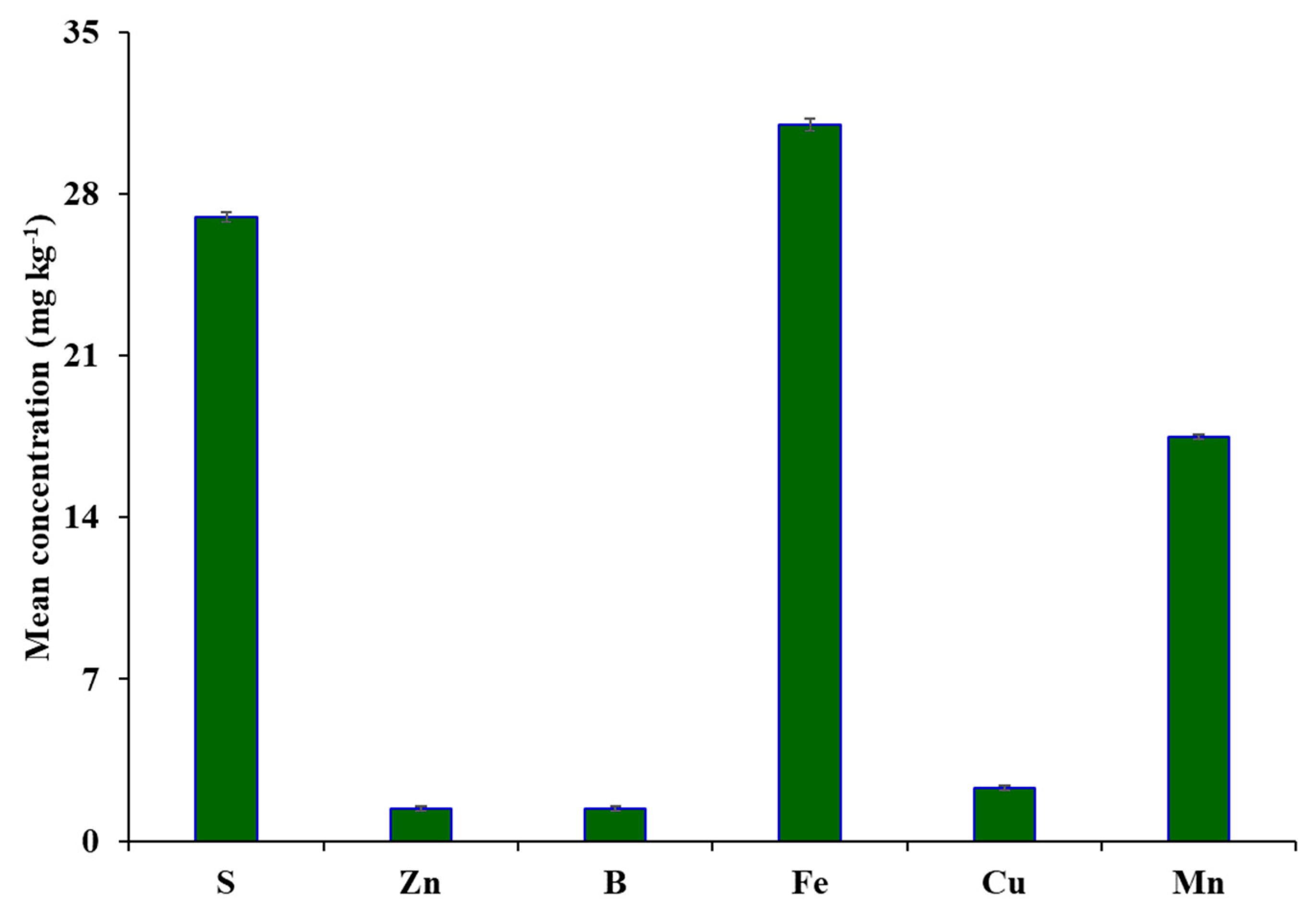
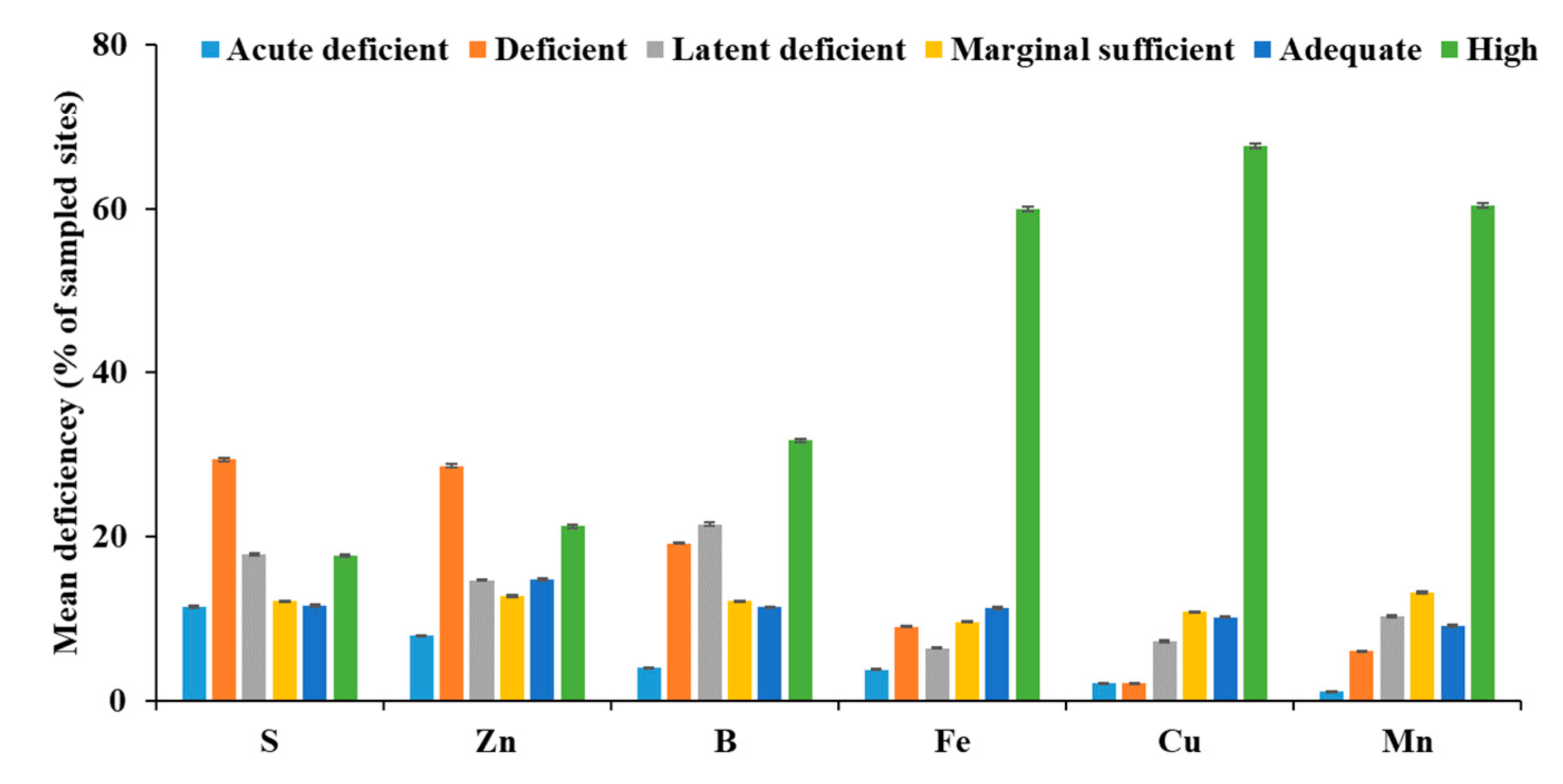
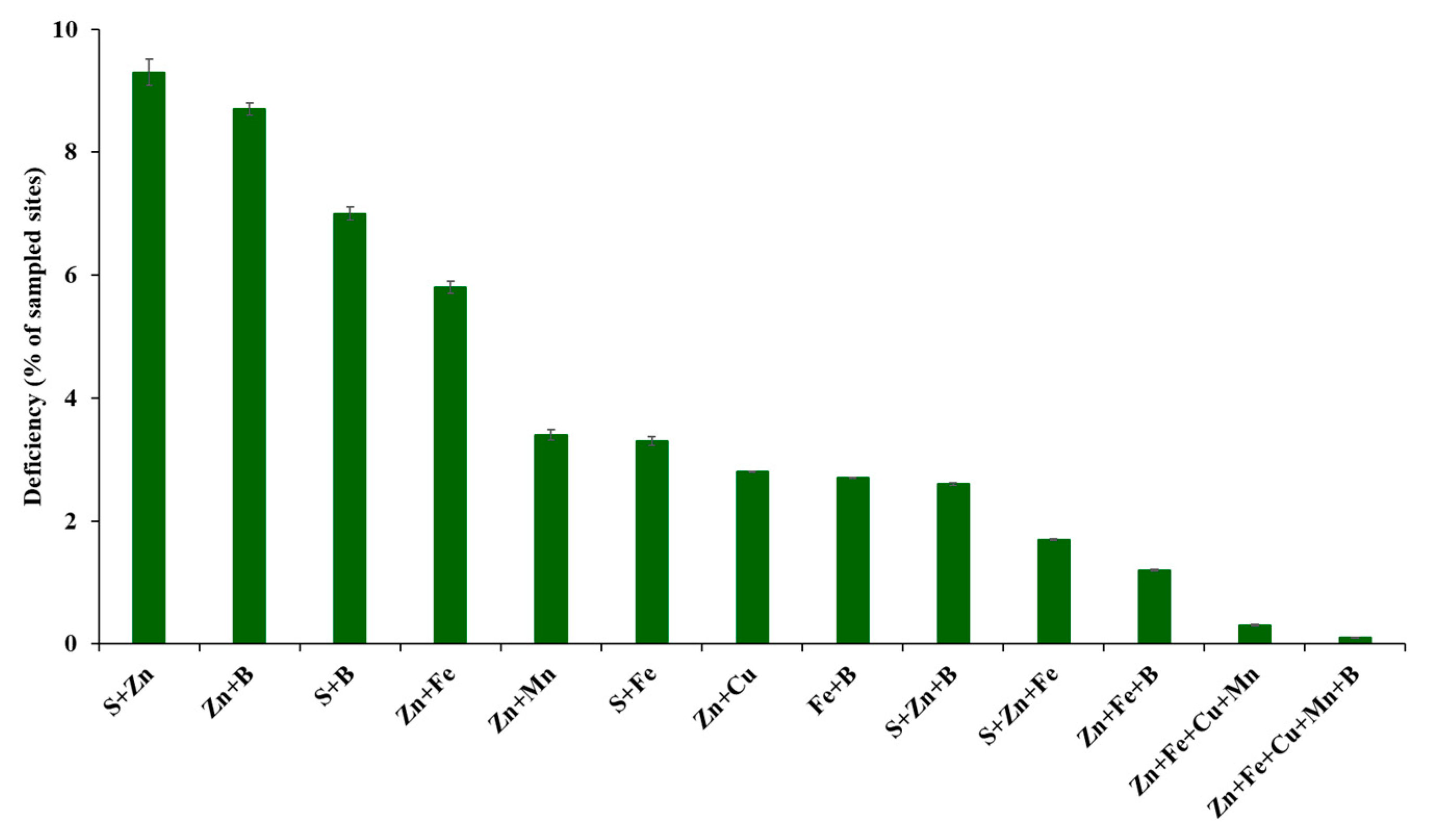
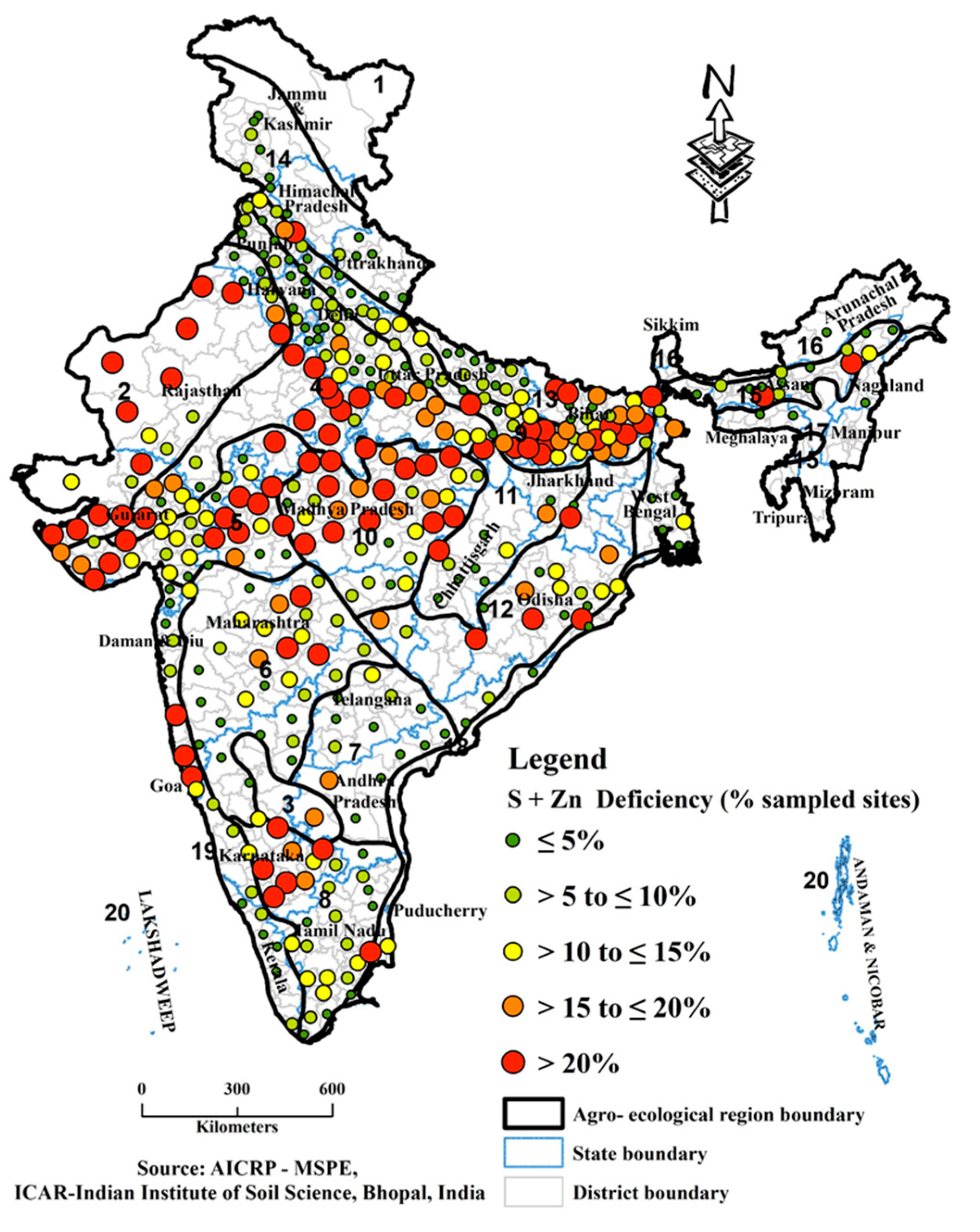
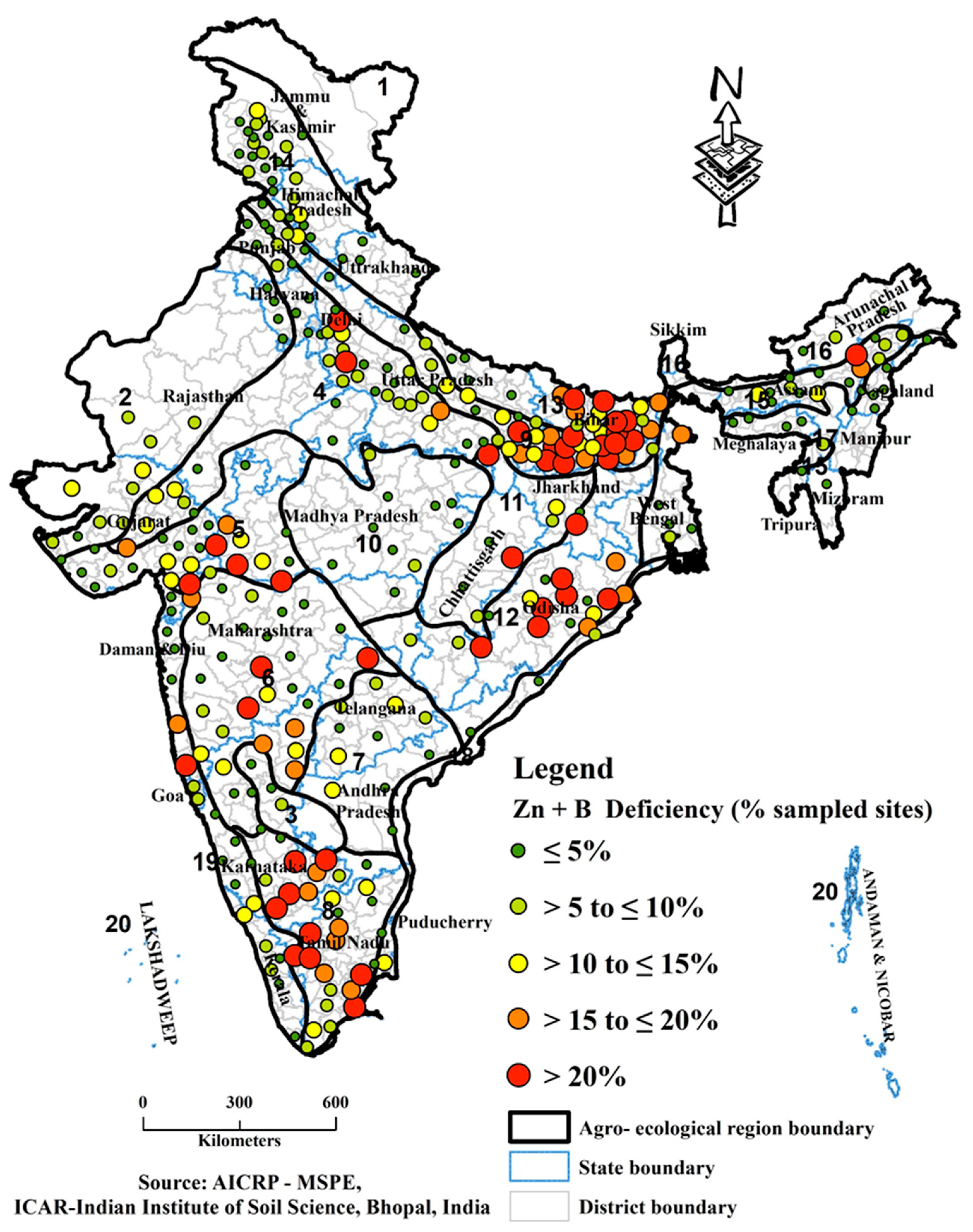
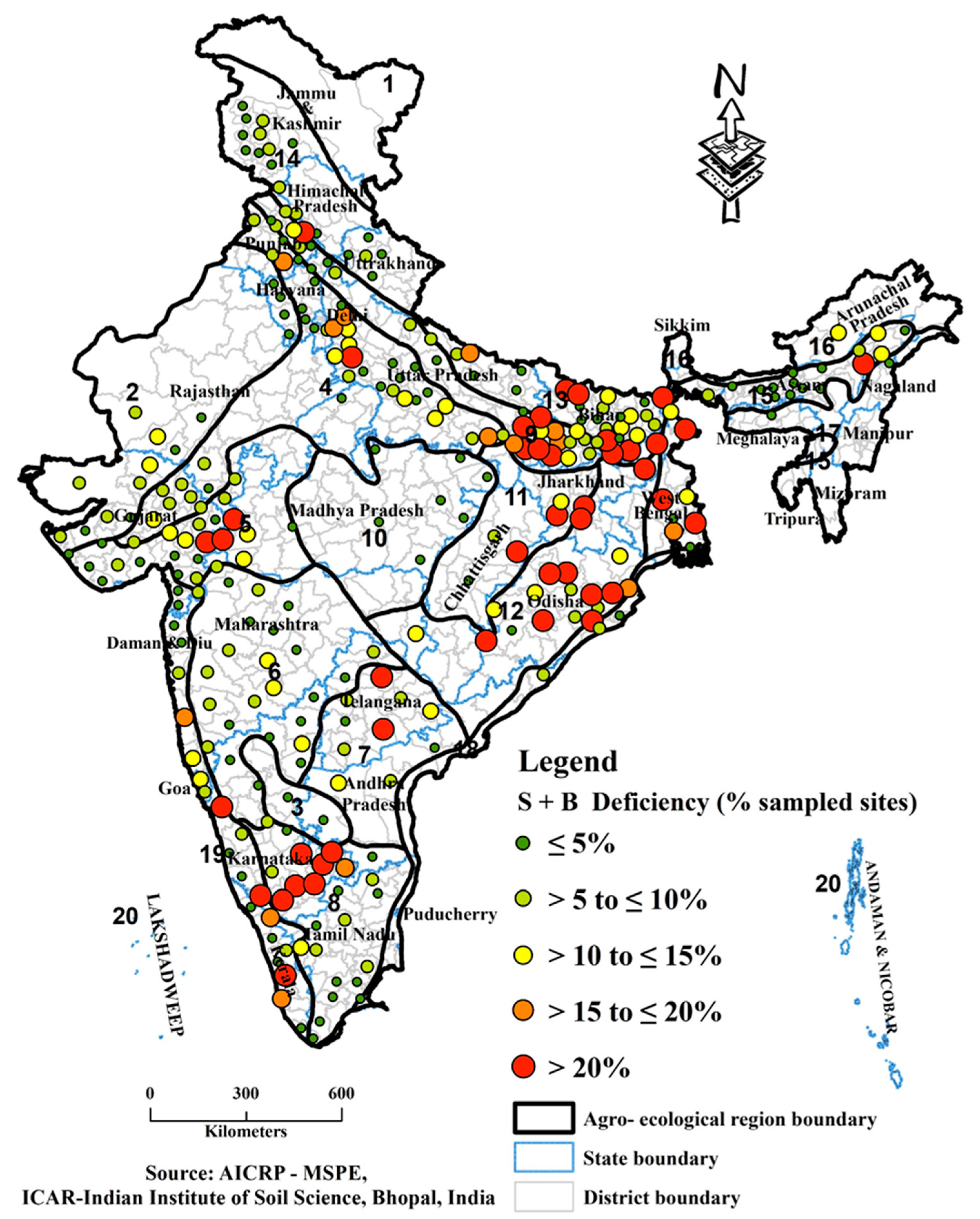
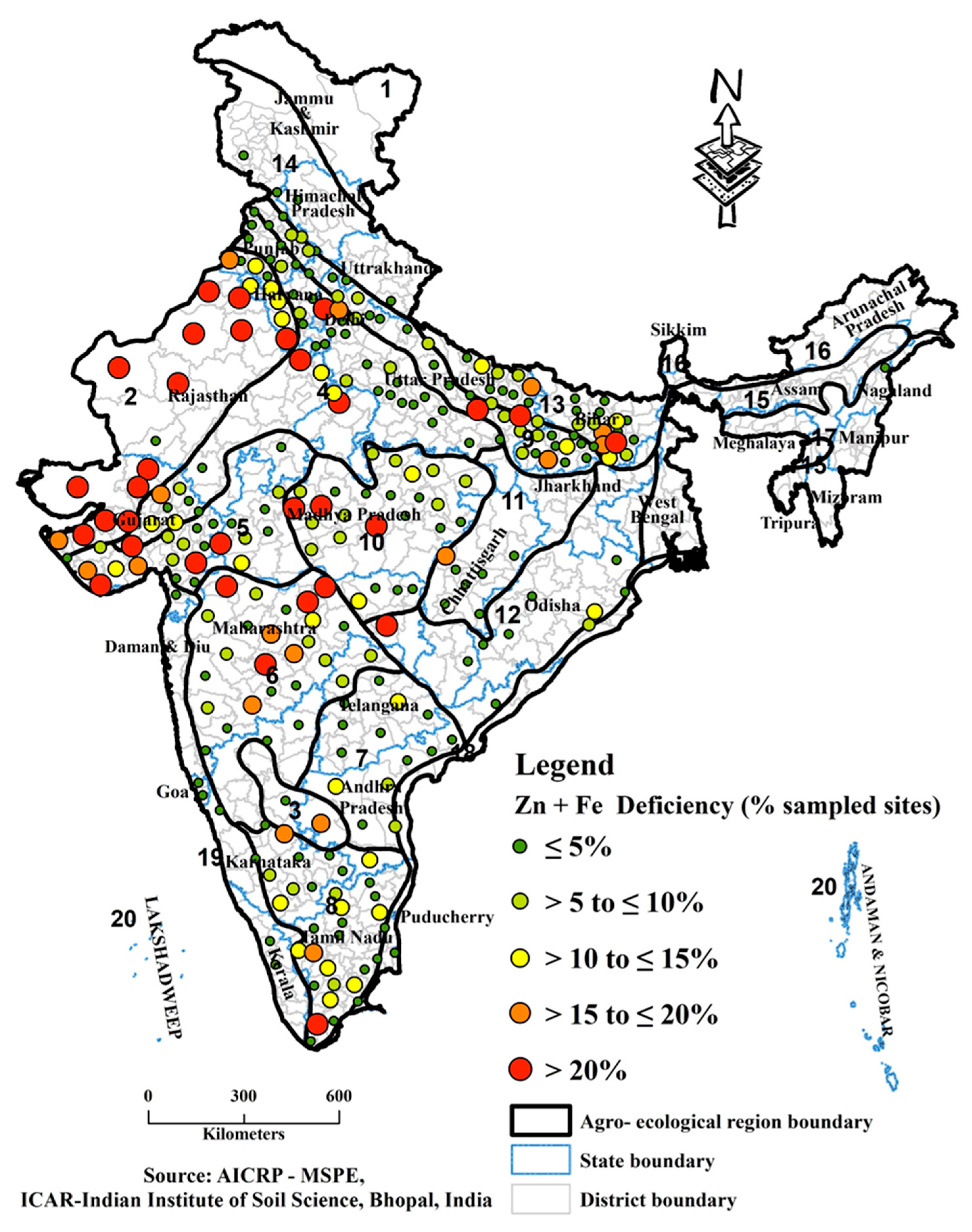
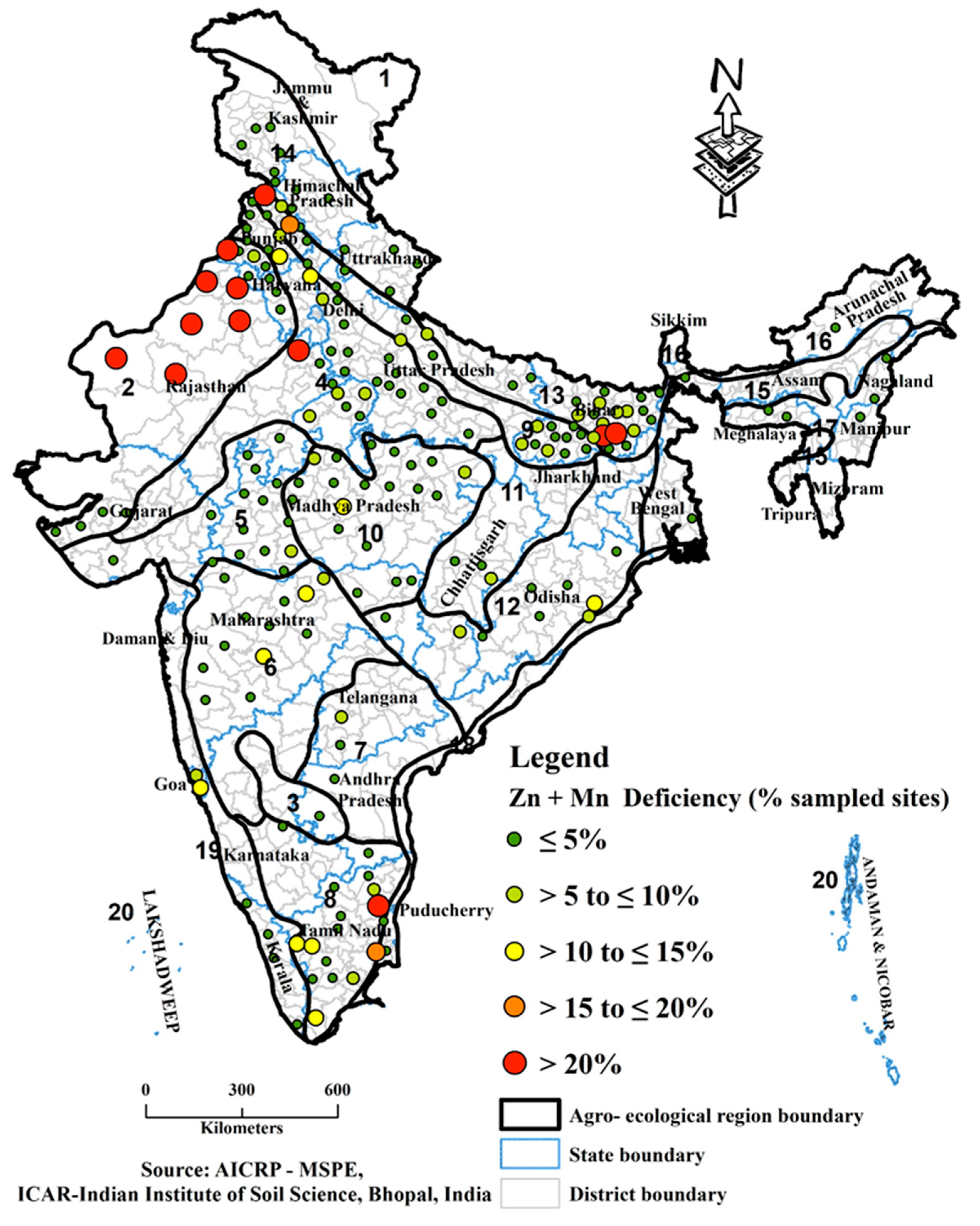
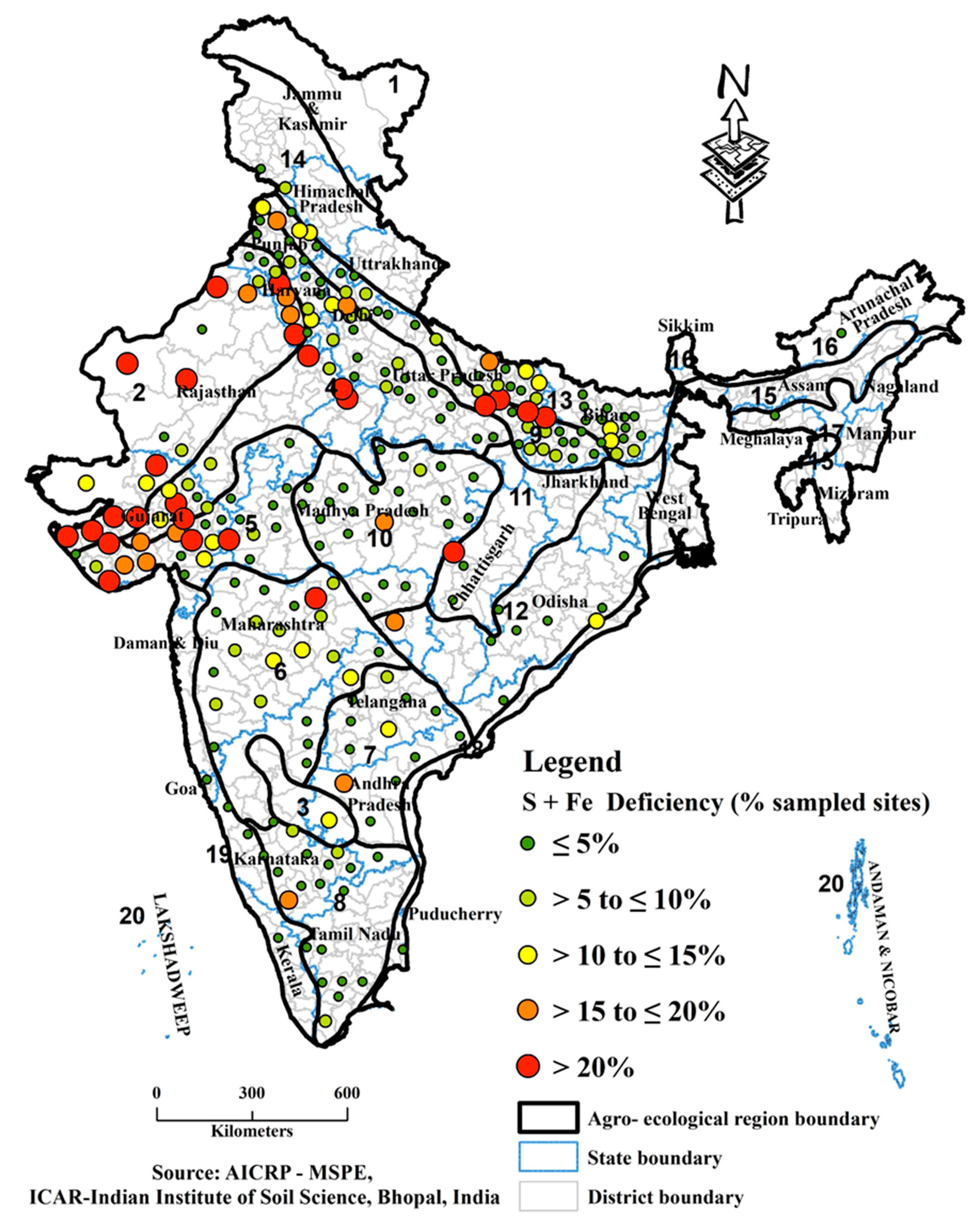
| Serial No. of Agro-Ecological Region | Name of Agro-Ecological Region | Climate Parameters |
|---|---|---|
| 1 | Cold arid eco-region with shallow skeletal soils | It experiences mild summer, harsh winter and receives mean annual rainfall of <150 mm. |
| 2 | Hot arid eco-region with desert and saline soils | It experiences hot summer and cool winter and receives mean annual rainfall of <400 mm. |
| 3 | Hot arid eco-region with red and black soils | It experiences hot and dry summer, mild winter and receives mean annual rainfall of 400–500 mm. |
| 4 | Hot semi-arid eco-region with alluvium derived soils | It experiences hot and dry summer, cool winter and receives mean annual rainfall of 500–1000 mm. |
| 5 | Hot semi-arid eco-region with medium and deep black soils | It experiences hot and wet summer, dry winter and receives mean annual rainfall of 500–1000 mm. |
| 6 | Hot semi-arid eco-region with shallow and medium (dominant) black soils | It experiences hot and humid summer, mild and dry winter and receives mean annual rainfall of 600–1000 mm. |
| 7 | Hot semi-arid eco-region with red and black soils | It experiences hot and dry summer, mild and dry winter and receives mean annual rainfall of 600–1100 mm. |
| 8 | Hot semi-arid eco-region with red loamy soils | It experiences hot and dry summer, mild winter and receives mean annual rainfall of 600–1000 mm. |
| 9 | Hot sub-humid (dry) eco-region with alluvial-derived soils | It experiences hot summer, cool winter and receives mean annual rainfall of 1000–1200 mm. |
| 10 | Hot sub-humid eco-region with red and black soils | It experiences hot summer, mild winter and receives mean annual rainfall of 1000–1500 mm. |
| 11 | Hot sub-humid eco-region with red and yellow soils | It experiences hot summer, cool winter and receives mean annual rainfall of 1200–1600 mm. |
| 12 | Hot sub-humid eco-region with red and lateritic soils | It experiences hot summer, cool winter and receives mean annual rainfall 1000–1600 mm. |
| 13 | Hot sub-humid (moist) eco-region with alluvium-derived soils | It experiences hot and wet summer, cool and dry winter and receives mean annual rainfall of 1400–1800 mm. |
| 14 | Warm sub-humid to humid with inclusion of perhumid eco-region with brown forest and podzolic soils | It experiences mild summer, cool winter and receives mean annual rainfall of 1000–2000 mm. |
| 15 | Hot sub-humid (moist) to humid (inclusion of perhumid) eco-region with alluvium-derived soils | It experiences hot summer, mild to moderately cool winter and receives mean annual rainfall of 1400–1600 mm. |
| 16 | Warm sub-humid eco-region with brown and red hill soils | It experiences warm summer, cool winter and receives mean annual rainfall of 2000 mm. |
| 17 | Warm perhumid eco-region with red and lateritic soils | It experiences warm summer, cool winter and receives mean annual rainfall of 2000–3000 mm. |
| 18 | Hot sub-humid to semi-arid eco-region with coastal alluvium-derived soils | It experiences semi-arid and sub-humid (moist) climate and receives mean annual rainfall of 900–1100 mm (west coast) and 1200–1600 mm (east coast). |
| 19 | Hot humid perhumid eco-region with red, lateritic and alluvium-derived soils | It experiences hot and humid summer, warm winter and receives mean annual rainfall of >2000 mm. |
| 20 | Hot humid per-humid island eco-region with red loamy and sandy soils | It experiences tropical climate and receives mean annual rainfall of 1600–3000 mm. |
| Serial No. of Agro-Ecological Region | Nature of Soil | Commonly Cultivated Crops |
|---|---|---|
| 1 | Soils are skeletal, calcareous and alkaline in reaction. | Vegetables, millets, wheat, fodder, pulses and barley. |
| 2 | Soils are sandy, moderately calcareous and alkaline in reaction. | Pearl millet, fodder, pulses, cotton, sugarcane, mustard, wheat and gram. |
| 3 | Soils are shallow, medium red soil with slightly acidic and noncalcareous nature. Soils are also deep, clayey black with slightly alkaline and calcareous nature. | Pearl millet, groundnut, sugarcane, sunflower and cotton. |
| 4 | Soils are deep, loamy and alluvium derived and clayey mixed red and black. | Rice, millets, maize, pulses, berseem, wheat, mustard and sugarcane, jowar, pigeon pea, soybean, lentil and cotton. |
| 5 | Soils are deep loamy to clayey black soil with slightly alkaline and calcareous nature with swell-shrink characters. | Sorghum, pearl millet, pigeon pea, groundnut, soybean, maize, pulses, safflower, sunflower and wheat. |
| 6 | Soils are shallow, loamy skeletal, clayey, calcareous and moderately alkaline in reaction. | Sorghum, pearl millet, pigeon pea, safflower, sunflower, cotton and groundnut. |
| 7 | Soils are red, non-calcareous and neutral in reaction, clayey and calcareous with alkaline in reaction. | Sorghum, pigeon pea, rice, cotton, groundnut, sunflower, safflower, castor. |
| 8 | Soils are non-calcareous and slightly acidic soil, and calcareous and moderately alkaline. | Millets, pulses, groundnut, sorghum and sunflower. |
| 9 | Soils are alluvium derived deep and loamy with neutral in reaction. | Rice, maize, barley, pigeon pea, jute, wheat, lentil, mustard, cotton and sugarcane. |
| 10 | Soils are deep black calcareous soil with slightly alkaline in reaction, moderately deep, clayey red with neutral to slightly acidic in reaction. | Rice, wheat, sorghum, soybean, pigeon pea, gram, cotton and vegetables. |
| 11 | Soils are deep, loamy, non-calcareous, red and yellow with neutral to slightly alkaline in reaction. | Rice, wheat, millets, pigeon pea, green gram and black gram. |
| 12 | Soils are fine loamy to clayey, non-calcareous red soil with slightly to moderately acidic in reaction. | Rice, wheat, pulses and groundnut. |
| 13 | Soils are deep, loamy, calcareous with moderately alkaline in reaction. | Rice, maize, moong, pigeon pea, lentil, wheat, sesamum, groundnut, sugarcane, tobacco, turmeric, chilies, potato and coriander. |
| 14 | Soils are shallow to deep brown forest and podzolic soil, fine loamy and neutral to mildly alkaline in reaction. | Wheat, millet, maize, rice and apple. |
| 15 | Soils are slight to strongly acidic. | Rice, wheat, jute, tea, pineapple, citrus, banana, pulses, oilseed and sugarcane. |
| 16 | Soils are shallow to moderately shallow, loamy brown forest soil with moderately acidic in reaction. | Rice, maize, millet, potato, sweet potato, sesamum, pulses, cotton, mesta, sugarcane, pineapple, citrus, apple, pear, peach, banana and medicinal plants. |
| 17 | Soils are shallow to very deep, loamy, red and lateritic, red and yellow with acidic in reaction. | Rice, millets, maize, potato, tea, coffee, rubber, orange, pineapple, jute, mustard, black gram, green gram and lentil. |
| 18 | Soils are clayey and slight to moderately sodic. | Rice, coconut, black gram, lentil, sunflower and groundnut. |
| 19 | Soils are deep, clayey red, lateritic, alluvium derived and strongly to moderately acidic in reaction. | Rice, tapioca, coconut and spices. |
| 20 | Soils are medium to very deep red-loamy, marine-derived, calcareous sandy with slightly to strongly acidic in reaction. | Rice, coconut, arecanut, oil palm, tapioca and pepper. |
| Nutrients | Minimum | Maximum | Mean | SD | CV (%) | Skewness | Kurtosis |
|---|---|---|---|---|---|---|---|
| S (mg kg−1) | 0.02 | 822 | 27.0 | 29.9 | 111 | 4.28 | 35.6 |
| Zn (mg kg−1) | 0.01 | 59.8 | 1.40 | 1.60 | 118 | 7.35 | 118 |
| B (mg kg−1) | 0.01 | 109 | 1.40 | 4.70 | 338 | 12.8 | 189 |
| Fe (mg kg−1) | 0.01 | 964 | 31.0 | 52.2 | 168 | 5.53 | 47.3 |
| Cu (mg kg−1) | 0.01 | 99.2 | 2.30 | 3.50 | 153 | 10.8 | 186 |
| Mn (mg kg−1) | 0.01 | 483 | 17.5 | 21.4 | 122 | 5.72 | 59.7 |
Publisher’s Note: MDPI stays neutral with regard to jurisdictional claims in published maps and institutional affiliations. |
© 2021 by the authors. Licensee MDPI, Basel, Switzerland. This article is an open access article distributed under the terms and conditions of the Creative Commons Attribution (CC BY) license (https://creativecommons.org/licenses/by/4.0/).
Share and Cite
Shukla, A.K.; Behera, S.K.; Prakash, C.; Patra, A.K.; Rao, C.S.; Chaudhari, S.K.; Das, S.; Singh, A.K.; Green, A. Assessing Multi-Micronutrients Deficiency in Agricultural Soils of India. Sustainability 2021, 13, 9136. https://doi.org/10.3390/su13169136
Shukla AK, Behera SK, Prakash C, Patra AK, Rao CS, Chaudhari SK, Das S, Singh AK, Green A. Assessing Multi-Micronutrients Deficiency in Agricultural Soils of India. Sustainability. 2021; 13(16):9136. https://doi.org/10.3390/su13169136
Chicago/Turabian StyleShukla, Arvind Kumar, Sanjib Kumar Behera, Chandra Prakash, Ashok Kumar Patra, Ch Srinivasa Rao, Suresh Kumar Chaudhari, Soumitra Das, Anil Kumar Singh, and Andrew Green. 2021. "Assessing Multi-Micronutrients Deficiency in Agricultural Soils of India" Sustainability 13, no. 16: 9136. https://doi.org/10.3390/su13169136
APA StyleShukla, A. K., Behera, S. K., Prakash, C., Patra, A. K., Rao, C. S., Chaudhari, S. K., Das, S., Singh, A. K., & Green, A. (2021). Assessing Multi-Micronutrients Deficiency in Agricultural Soils of India. Sustainability, 13(16), 9136. https://doi.org/10.3390/su13169136








